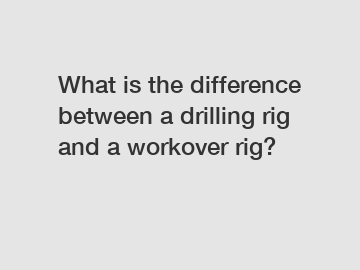What is the difference between a drilling rig and a workover rig?
What is the difference between a drilling rig and a workover rig?
Drilling rigs and workover rigs are both essential equipment used in the oil and gas industry. While they may seem similar at first glance, there are key differences between the two that make them suitable for different purposes. In this article, we will explore the distinctions between a drilling rig and a workover rig.
1. Purpose.

The primary difference between a drilling rig and a workover rig lies in their respective purposes. A drilling rig is used to drill new wells and explore for underground resources such as oil and gas. On the other hand, a workover rig is employed to perform maintenance and repair work on existing wells. This could involve tasks such as replacing worn-out equipment, cleaning out debris, or enhancing production levels.
2. Equipment.
Drilling rigs are equipped with specialized machinery designed to penetrate deep into the earth's surface and extract resources. These rigs typically feature a derrick, drill pipe, drill bit, and other components necessary for drilling operations. In contrast, workover rigs are outfitted with tools suited for well intervention activities, such as wireline units, slickline units, and hydraulic workover units.
3. Depth and Complexity.
Drilling rigs are used to drill new wells that can extend thousands of feet below the surface. As a result, they are designed to handle high-pressure environments and the complexities associated with exploring for resources in deep-sea or land locations. Workover rigs, on the other hand, are typically used for shallower wells and less complicated tasks. They are more suited for performing maintenance work in wells that have already been drilled.
4. Cost and Efficiency.
Drilling rigs are generally more expensive to operate and maintain compared to workover rigs. The complexities involved in drilling new wells require specialized equipment and a higher level of expertise, which can drive up costs. Workover rigs, by contrast, are more cost-effective and are often used to optimize production in existing wells without the need for extensive drilling operations. This can result in improved efficiency and lower overall expenses for oil and gas companies.
In conclusion, the differences between a drilling rig and a workover rig are significant and play a crucial role in the operations of the oil and gas industry. Understanding the distinct purposes, equipment, depth, complexity, cost, and efficiency of these two types of rigs is essential for companies looking to maximize their resources and achieve successful outcomes in exploration and production activities. Whether it be drilling new wells or maintaining existing ones, selecting the right rig for the job is key to ensuring operational success and profitability in the competitive oil and gas sector.
For more land oil drilling rig for sale, elevator links drilling company, api-7k triplex mud pumps custominformation, please contact us. We will provide professional answers.
186
0
0

Comments
All Comments (0)